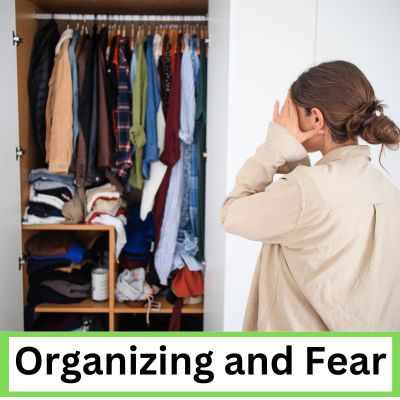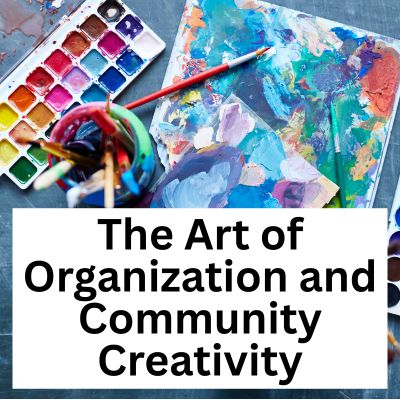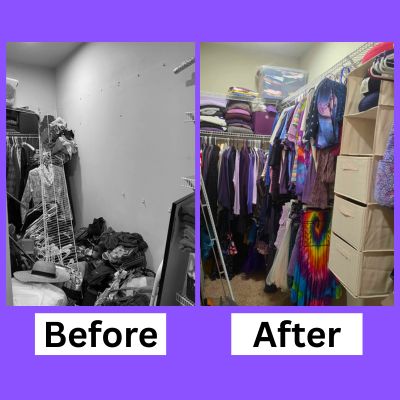Organizing and Fear

When people have trouble with decluttering and organizing, the four most common issues people say is the problem are: a lack of skills, a lack of time, a lack of space, or a health based issue such as mobility or cognitive challenges. Many times, it’s a combination of all of these issues. But what often is unrecognized is the massive amount of fear that can be associated with going through your stuff. In this post, I’ll talk about some different types of fears people experience when organizing. I’ll describe behaviors that may indicate that you have fear associated with going through your stuff. Finally, I’ll give you some tips on how to move through your fear so you can overcome your clutter.
Common Fears Associated With Decluttering and Organizing
Here are just a handful of reasons that might be holding you back. Feel free to add any of your own.
- You’re afraid you might need it again. This could include a fear of letting go or a fear of regret.
- You’re afraid of the creepy crawly spiders that might be lingering within your clutter.
- You’re afraid you’re going to find old bills and owe a lot of money.
- You’re afraid to face the shame you feel about your clutter.
- You’re afraid of failure. You think organizing will take too much time. You’ve got more important things to do. You don’t think you’ll make any noticeable progress.
- You’re afraid of success. You’re afraid of what you could actually accomplish if you got yourself organized.
- You’re afraid of change. Your life is going really well right now, and maybe if the clutter stays just as it is, things will continue to go right.
- You’re afraid of challenging your own beliefs about yourself. Or, deep down, you’re afraid of proving wrong whoever ingrained the belief in your mind that you’re disorganized.
- You’re afraid that you won’t belong if you change your clutter situation. Maybe you have other important people in your life who are also very cluttered, and you have that in common. You might be afraid that if you get decluttered and organized, you won’t be accepted by your other cluttered peers anymore.
- You’re afraid of turning into another family member who has a bad problem with clutter, so you don’t want to attempt to declutter for fear that you also might discover you also have a problem. (In most cases of people who have this fear, your own problem is significantly magnified in your mind.).
- You’re afraid that you’ll be lonely without your clutter.
- You’re afraid that you won’t have any good excuses to not do thing or have people over if your house was in order.
- You’re afraid you wouldn’t get attention from other people who want to help you with your clutter, so you keep it cluttered.
- You’re afraid to face the memories that will be brought to the surface as you go through your stuff. These memories might be bad, painful, traumatic, or filled with regret. You might also have some really good memories within your clutter, but there could also be a tinge of sadness because those people, pets, places, or times don’t exist in the physical world anymore.
Unhealthy Emotional Buffering
Emotional buffering is when people use distractions to avoid confronting challenging emotions. Here are some examples:
Mind numbing distractions: phone scrolling, over-eating, over-shopping, binge watching TV, over-working, over-exercising, etc. In other words, “checking out”. Of course it’s fine to do these things once in a while, but problems arise when these activities become chronic.
Manifesting problems for yourself: Sometimes, your subconscious fights you so bad, that it will manifest real problems to prevent you from doing what you consciously want to be doing. But sometimes real problems just happen, and they have nothing to do with subconscious avoidance techniques.
Distracting yourself by being “productive” (my favorite buffering technique ): This is when those tedious little tasks that need to get done finally get done. Or maybe you overcome the hurdle of doing something challenging that you’ve been avoiding (but it’s not the even bigger thing you’ve been avoiding). Or maybe you finally have the inspiration to start going to the gym. Or you decide that today is the day that you clean something that requires a lot of detail-oriented patience. There’s a difference with being productive and getting this stuff done on a more normal schedule versus doing it to avoid facing a fear.
Distracting yourself with other people’s problems: This can easily get masked under the disguise as being “helpful”, “caring”, “a good listener”, or “a hero”. There are certainly times when you really do want to be there for others. But when you habitually abandon your personal responsibilities for the sake of others, it can be detrimental to your health and well-being. This behavioral pattern is called co-dependence.
Healthy Emotional Buffering
I was recently reading The Official Ahimsa Dog Training Manual, a dog-training book that used a beach metaphor to describe teaching a dog to overcome their fear and aggression behaviors. There were 5 stages: on the beach:
1: Ideal- “playing on the beach”, noticing the trigger
2: OK- “stopping at the shoreline”, curious about the trigger
3: Small hints- “getting feet wet”, intent on trigger
4: Call away- “going a little deeper”, difficulty disengaging with trigger
5: Get away- “under water”, being reactive/aggressive towards trigger
As a human, you can notice where you are on this scale in regards to your own fears. The goal would be to catch yourself and “call yourself back” before you get under water. If you go too deep too soon, your emotions will likely get the best of you, and you won’t be effective because you can’t think straight. Gradually yourself to the trigger in a safe yet challenging manner. As you notice your fear meter rising, make sure to take a break to self-soothe rather than forcing yourself to do more than you’re ready for. This is called “healthy emotional buffering”. With healthy emotional buffering, you are consciously using a buffer to create space for emotional recovery. Here are some ideas to help “call yourself back”.
- Kind of like how people use fidget spinners to concentrate, expose yourself to your fear as you’re doing something else. For example, you could try watching TV or listening to music as you organize, chop vegetables as you’re thinking about how to tackle your boxes, or let yourself have a favorite snack as you process your paperwork.
- Remind yourself that decluttering and organizing can be like peeling an onion. It’s normal to need to take multiple passes at stuff. When in doubt about what to do, try categorizing your stuff into “easy to deal with”, “challenging to deal with”, and “dealing with this is like a black hole” type categories.
- When you notice your fear starting to escalate and you feel tempted to reach for one of your unhealthy buffering techniques, interrupt the brain pattern by quickly engaging your senses (either in real life or in your imagination). Conjure up your favorite thing to look at, smell, taste, feel, or hear. My personal go-to is often thinking about kissing a horse on their nose.
- Use EFT (Emotional Freedom Technique) Tapping. This is a great way to calm the nervous system while also addressing the emotional distress. Because you’re tapping on specific acupressure points, you can reduce your body’s stress response. It’s a very non-threatening way to help your brain process and release emotions. EFT can actually help you change the way you think about and respond to triggers! (I know this because I use this technique often.).
- Use Flower Essences to help take the edge off. You can find the Bach Flowers “Rescue Remedy” at many grocery stores. I’m also a fan of the Perelandra ETS. My friend Erin Mullins makes custom flower essences blends. You can get flower essences for humans and for pets.
- Use the 5-5-7 Breathing Technique. Breathe in for 5 seconds, hold for 5 seconds, breathe out for 7 seconds. Repeat this 10 times. By calming your nervous system rather than letting your fear get the best of you, you are teaching yourself that this situation is ok. When you don’t calm yourself and you let your fear get the best of you, it reinforces your belief that this situation is unsafe.
- When you really get hung up and your mind is ruminating, ask yourself:
- What is the problem? Be very clear. You may even want to write it down. Don’t skip this step.
- Is this problem within your control? If yes- what can you do about it? If no, is there anything you can do?
- Do what is within your control. If it is not within your control and there is nothing you can do about it, you need to learn to redirect your thought patterns to things that are within your control. I know it can be very tempting to fixate on things that aren’t within your control, but this is not healthy.
- Get your thoughts and emotions back to a more joyful state as quickly as possible. Things will work out much better if you can do this.
So the next time you feel inspired to avoid organizing and decluttering, try these tips to see if they help you ease in to what you want to accomplish.

Posted By Jean Prominski, Certified Professional Organizer
- Follow me on Instagram @carlsbadsparkle
- Join my Facebook Group, Declutter and Organize with SparkleHomeOrganizing.
- Ready to book a consultation? Complete this form.
- For artwork to energize your home, order through jeanprominski.com.




